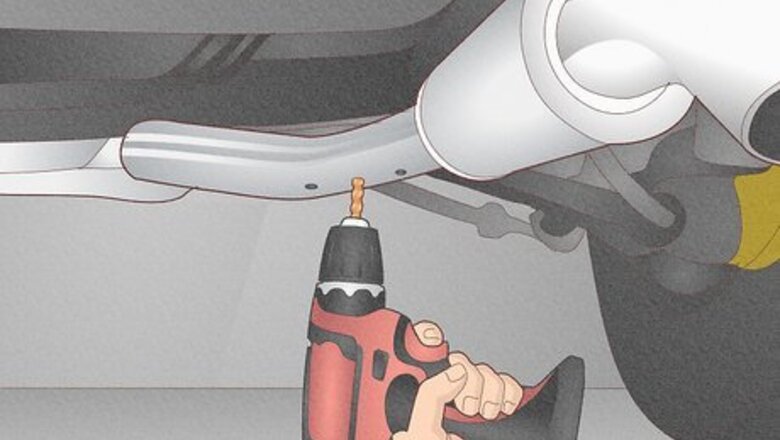
views
- Drill small holes in your exhaust pipes to make your car louder–it’s a legal way to modify your exhaust system, and it's much safer than removing your muffler.
- Clean, degrease, and polish your exhaust pipes to amplify the sound of your exhaust system.
- Install a dual exhaust cat-back system to boost the horsepower of your car and create an aggressive roar.
Drill holes in your exhaust pipes.
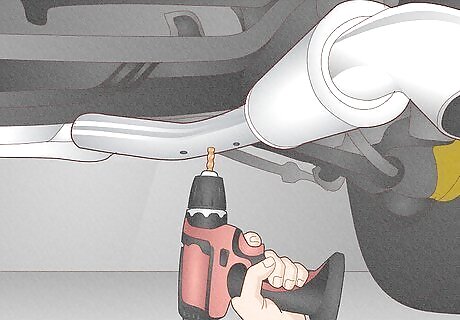
Perforating the exhaust allows more sound waves to escape. Use a 0.38 inch (0.95 cm) cobalt-tipped drill bit to pierce 6-8 small holes on the pipe between the muffler and catalytic convertor. These holes let sound waves exit before reaching the muffler, giving your car a more aggressive sound. Be sure to drill these holes after your catalytic convertor so the exhaust fumes convert into non-toxic ones. Otherwise, harmful gasses may enter your cabin. If you’re not happy with the sound, you can always drill additional holes or try a larger drill bit.
Clean your exhaust pipes.

Clear your exhaust pipes of sound-blocking carbon deposits. When debris builds up in your exhaust pipes, it decreases engine performance and sound. Remove the grime in your pipes by cleaning them with soap and water, and then apply degreaser all over the exhaust. Use steel wool to scrub the product off, and finish by applying metal polish on the exhaust tips. Alternatively, use a carbon cleaning service to increase the sound of your vehicle. Depending on your vehicle and engine type, professional treatment ranges from $125-325.
Add an exhaust tip.
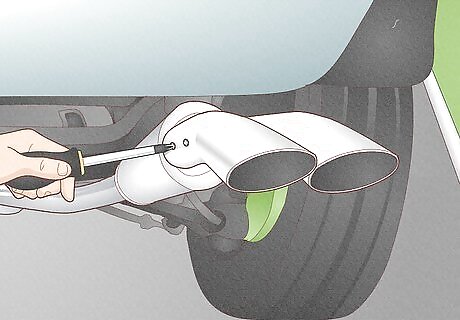
Attach an exhaust tip to your tailpipe to amplify your engine's sound. Whether you want a smooth purr or aggressive roar, these small but mighty components allow you to customize and increase the volume of your vehicle. Choose a larger tip for a deep, hearty sound, or opt for a smaller tip for more rasp. Exhaust tips range between $25-150, depending on the quality of the material. Many car enthusiasts prefer double-walled exhaust tips over single-walled ones because they produce a fuller sound.
Get a new muffler.

Select a straight-through muffler for maximum sound. This type of muffler allows exhaust gasses and sound waves to exit easily, boosting the volume and efficiency of your vehicle. To achieve the sound you want, experiment with muffler placement: most mufflers are located near the vehicle’s rear end, but move it closer to the engine (along the tailpipe) for an even louder roar. Avoid s-type mufflers that have lots of baffles–they tend to absorb sound. The average cost to replace a muffler ranges from $160-240.
Delete your resonator.
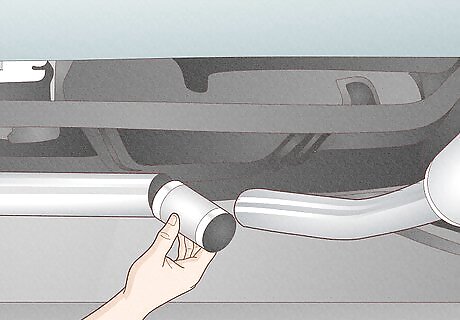
Make your muffler less effective with a resonator delete. Like a muffler, the resonator is a hollow pipe that minimizes the noise of your engine. It’s directly attached to the exhaust system, and it’s often filled with a cotton-like material to better absorb sound. Since the resonator is attached before the muffler, removing the resonator makes the muffler less effective—the latter has to reduce more of the engine’s raw sound. A resonator delete also changes your vehicle’s signature sound to a deep, smooth roar. The total cost of a professional resonator delete costs between $100-220, depending on your car’s make and model.
Make your exhaust pipes bigger.
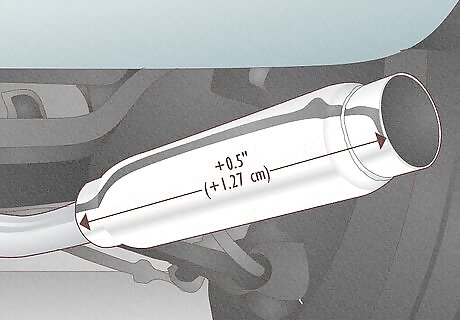
Increase your exhaust pipes by 0.5 inch (1.27 cm) for a major roar. The exhaust system includes all the components that are responsible for the majority of your vehicle’s sound–the exhaust pipes, muffler, and resonator. Switch to bigger pipes to increase the flow of gas in your vehicle and allow more sound to easily exit your vehicle. If your pipe diameter is too big, it creates excessive back pressure, so only increase your pipes by 0.5 inch (1.27 cm) to 1 inch (2.54 cm). Depending on your vehicle’s make and model, it costs about $835-860 to replace your exhaust pipes–including parts and labor.
Convert to a straight-pipe exhaust system.
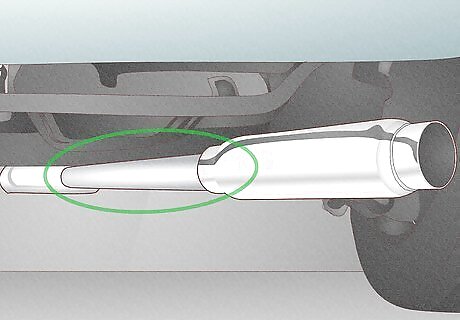
Replace your noise-suppressing exhaust with a loud straight-pipe. This modification removes the catalytic convertor, resonator, and muffler, replacing it with a straight, single tube. The design of the tube allows sound to travel more easily, with some systems reaching over 120 decibels. Due to noise and emission regulations, driving without a catalytic convertor is illegal in most states. Make sure to check your local laws to ensure you don’t get fined. Depending on your car and mechanic, expect to pay an average of $1500 for a professional straight-pipe set-up. For an at-home replacement, it generally costs between $75-200.
Switch to a cat-back exhaust.
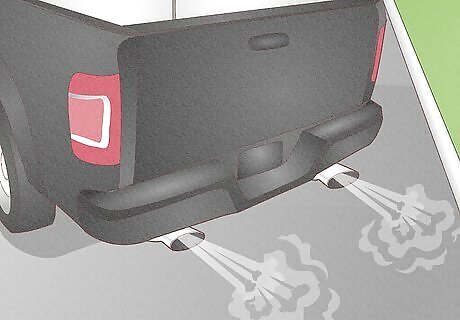
Choose a dual exhaust cat-back system to increase torque and volume. This modification reduces pressure on your engine, improving airflow and sound. Dual exhausts produce the most aggressive noise, but if you’re on a budget, choose a single exhaust cat-back system–it’s light, affordable, but still makes your car roar. Generally, stainless-steel cat-back exhaust systems cost between $150-400, but there are more affordable aluminum versions.
Install a turbocharger.

Amplify combustion sounds from your engine with a turbocharger. Since this device pushes more air into the engine’s cylinder (combustion chamber), it improves your vehicle’s overall performance and power. For an even louder sound, add a cold-air intake to your turbo; since cold air has more oxygen than warm air, cold-air intakes produce larger combustion in your engine. Alternatively, add a turbo whistle to your exhaust pipe for a similar effect to a turbocharger. Depending on the make and model of your vehicle, turbochargers range from $500-5000. Cold-air intakes usually cost between $30-100.
Run your car with open headers.

Remove your entire exhaust system for an aggressively loud ride. This method is when your vehicle doesn't have a muffler, exhaust pipe, or catalytic convertor. Since the exhaust gasses exit more easily, open headers dramatically increase the horsepower and sound of your ride. If you drive with open headers and have a larger engine (like a V6 or V8), your car may even release flames when revving to higher RPMs. To correctly run open headers, take your car to the shop for tuning. Prices typically range from $200-500, depending on whether you want a simple or complete tuning. Due to their loud noise and heavy emissions, open headers aren't legal in most states. Be sure to check your local laws to ensure you don’t get fined.
Upgrade your engine.
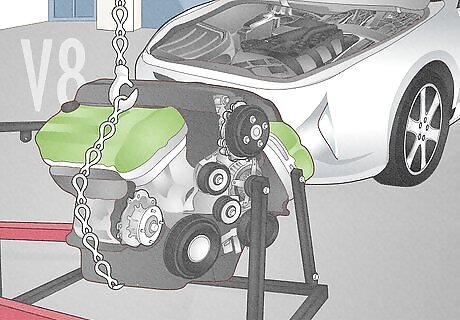
Swap to a V6 or V8 engine for a robust, resonant sound. The more cylinders your engine has, the more power and noise is produced. Unlike inline engines, V engines pack more cylinders into a small space, so they’re often featured in high-performance sports cars. If you prefer a smoother, even exhaust sound, choose an in-line engine instead. Inline-4s are the most common configuration in modern cars, so upgrade to an inline-6 for a bump in noise level. Replacing your engine is an expensive, time-consuming process, so most people don’t resort to this method. A new V8 engine can set you back about $7000 (excluding labor costs), so consider your vehicle’s age: if you’re driving an older car, purchasing a new vehicle might be a smarter decision.
Wire in engine-enhancing speakers.

Boost existing intake and engine noises with an exhaust mic. While uncommon, some specialty shops can attach ceramic microphones directly to the exhaust pipes, increasing the volume of your vehicle. Sometimes, they even add music to imitate these noises for extra roar. Some people can tell the difference between these fake sounds and authentic ones, so avoid this method if you prioritize sound quality and authenticity.



















Comments
0 comment